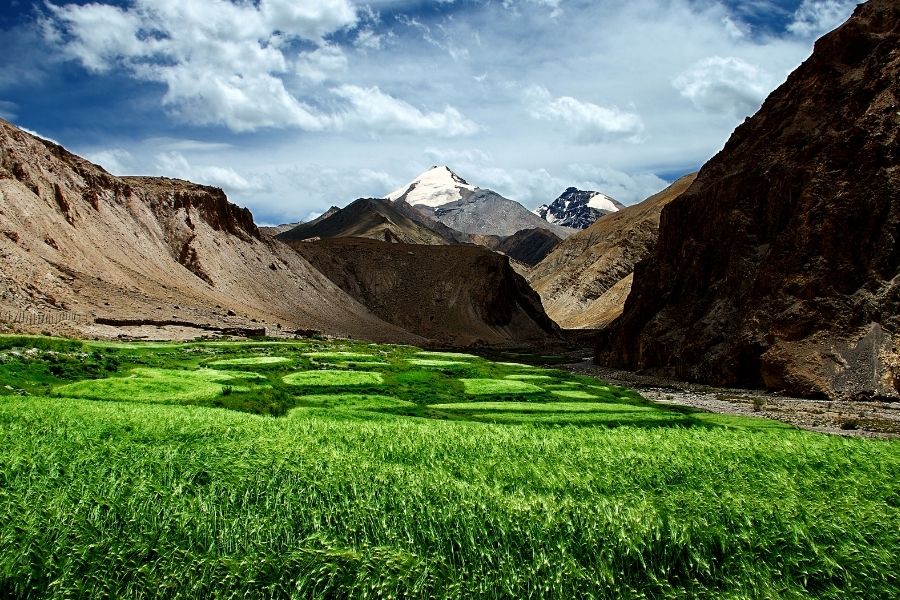In the last ten years, Kashmiri tourism is reviving and is favored as an all-year destination. Besides Indian couples on honeymoon, more and more foreigners turn their attention to Kashmir. It is the ultimate guide about the best places to visit and all the things you need to know before traveling to Kashmir.
- Where is Kashmir?
- What is Kashmir known for?
- Is it safe to travel to Kashmir in 2021?
- How to go to Kashmir?
- How to get around in Kashmir?
- What is the best time to visit Kasmir?
- Suggested itinerary for five days in Kashmir
- What are the famous places to visit in Kashmir?
- Srinagar – the city of lakes
- The Kashmiri cuisine – the famous wazwan
- The famous Pashmina shawl and Kashmir handicrafts
Although the name, Kashmir, sounds like an exotic place, the truth is that Kashmir lost its former excellent reputation, and it is about to regain it now. Some hundred years ago, it was the summer retreat of Mughal Emperors, and Kashmir’s beauty was described as follows: “If there is a paradise on earth, this is it, this is it.” The lush green valleys, the Islam gardens, and the snow-capped mountains depicted Kashmir as a mysterious place. Later, the British enjoyed the beauty and mild climate of the northernmost region. Not long ago, it was a top tourist destination. But due to safety issues, tourism shifted in the 1990s to Ladakh that remained safe, and opened up for visitors. By today, for foreigners, Kashmir still mainly means the disputed area between India and Pakistan. But the world-famous Kashmiri handicrafts, rugs, and Pashmina shawls never let the world forget about Kashmir.
Kashmir valley is not a place where you spend weeks unless you go hiking. Ideally, you connect it with a trip to Ladakh.
The ultimate guide to Ladakhi culture
The best itinerary to visit Kashmir and Ladakh
Where is Kashmir?
First, what do we understand under Kashmir indeed?
The official name of the Union Territory is Jammu & Kashmir (J&K). It includes Jammu region and the Kashmir valley. Ladakh was part of that until 2019. Then it became a seperate Union Territory. When I use Kashmir, I refer to the Indian Kashmir valley.
The Kashmir valley is the extensive riverbank of the Jhelum valley enclosed by the Himalayas and the Pir Panjal mountain ranges. It is one of the three regions of Jammu and Kashmir (J&K) state, and each of them has its unique characteristic and very different climate. Ladakh is a scarcely populated and dry region. Its inhabitants are mainly Tibetan Buddhists, while Jammu is primarily Hindu.
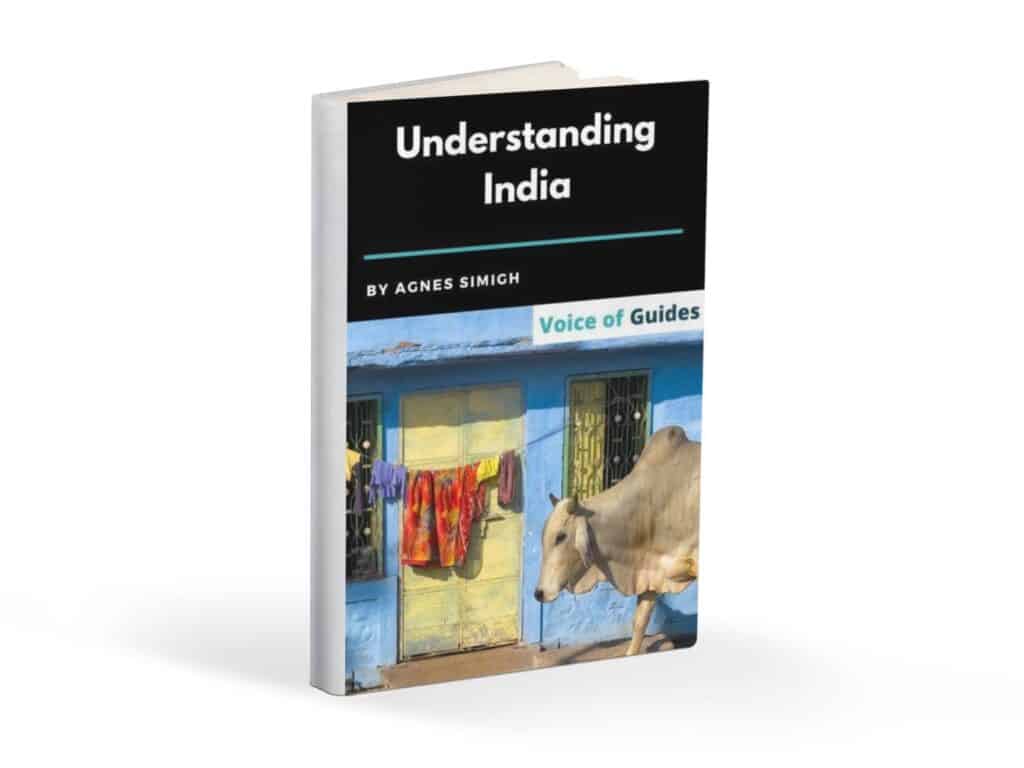
The Kashmir valley occupies 16% of J&K, but with 6.9 million inhabitants, it is the most populated region. Since 97% of the residents are Muslims, it makes J&K the only state in India with a Muslim majority. Most follow a mystical non-fundamentalist type of Islam, called Sufism, which originated in ancient Persia. In 2020, the Indian government passed a law after long debates, and Kashmiri became the official language in J&K Union Territory with Dogri, Hindi, English, and Urdu. Most Kashmiri speak Urdu or English as their second language, making it easy for foreigners to get along. In Kashmir, Urdu is preferred over Hindi.
What is Kashmir known for?
Kashmir is known for its lush greenery and forests, crystal-clear rivers, snow-capped mountains, and stunning gardens built by the Mughal Emperors. The region abounds in mountain lakes. The Dal and Nagin Lakes area in the center of Srinagar, with hundreds of houseboats anchored. Outside the city, the Wular Lake, one of Asia’s largest freshwater lakes, is essential for fishing activities, while the Manasbal lake is a birdwatcher’s paradise. The famous hill stations, Gulmarg, Pahalgam, and Sonmarg, once the favorite resorts for the British, offer a range of hotels to stay in and enjoy nature. In winter, they turn into attractive ski resorts.
The striking yellow vast saffron fields that Kashmir is world-famous for around Pampore are a treat for the eyes.
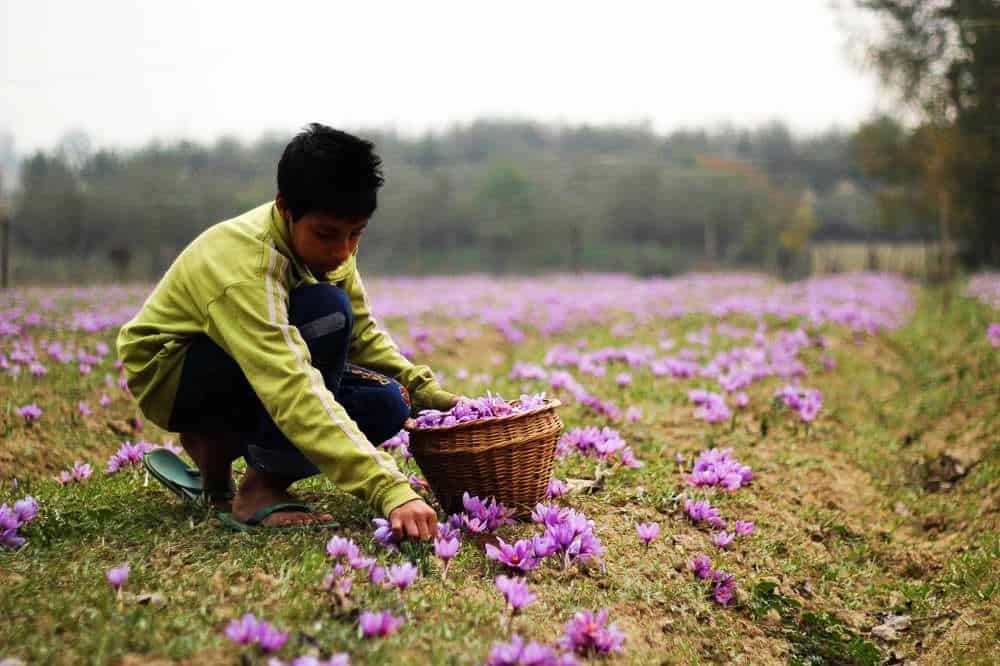
Between the 1960s and 1980s, Kashmir was the number one shooting place for Bollywood movies, and the Betaab valley carries the name of the movie shot there. The star actors were regular guests in Kashmir until the violence erupted in the 1990s.
Kashmir and Srinagar were always famous for their beauty. The Mughal Emperors, who ruled North and Central India (1526- 1847) till the British arrived, adored Kashmir. Especially Jahangir, who took the effort several times to make the long march through the Pir Panjal ranges with elephants and his populous household to retreat for some weeks in Kashmir.
The best itinerary to visit Kashmir and Ladakh
As Jahangir lay on his deathbed, his anxious courtiers asked him if there was anything that he wanted. “Only Kashmir” – he answered.
During Aurangzeb Mughal Emperor, the golden age of Kashmir ended. The valley was no longer the jewel of the Mughal Empire that the previous rulers protected above all others.
Once again, Kashmir became isolated, and the greedy local officials could behave as they pleased in the lack of control. Around this time, the Nehru family, the forebears of three Indian prime ministers, emigrated from Kashmir to Uttar Pradesh.
Then, the British became fond of the valley, who loved escaping from the humid and hot Indian Plateau to get some fresh air.
Pin it for later!
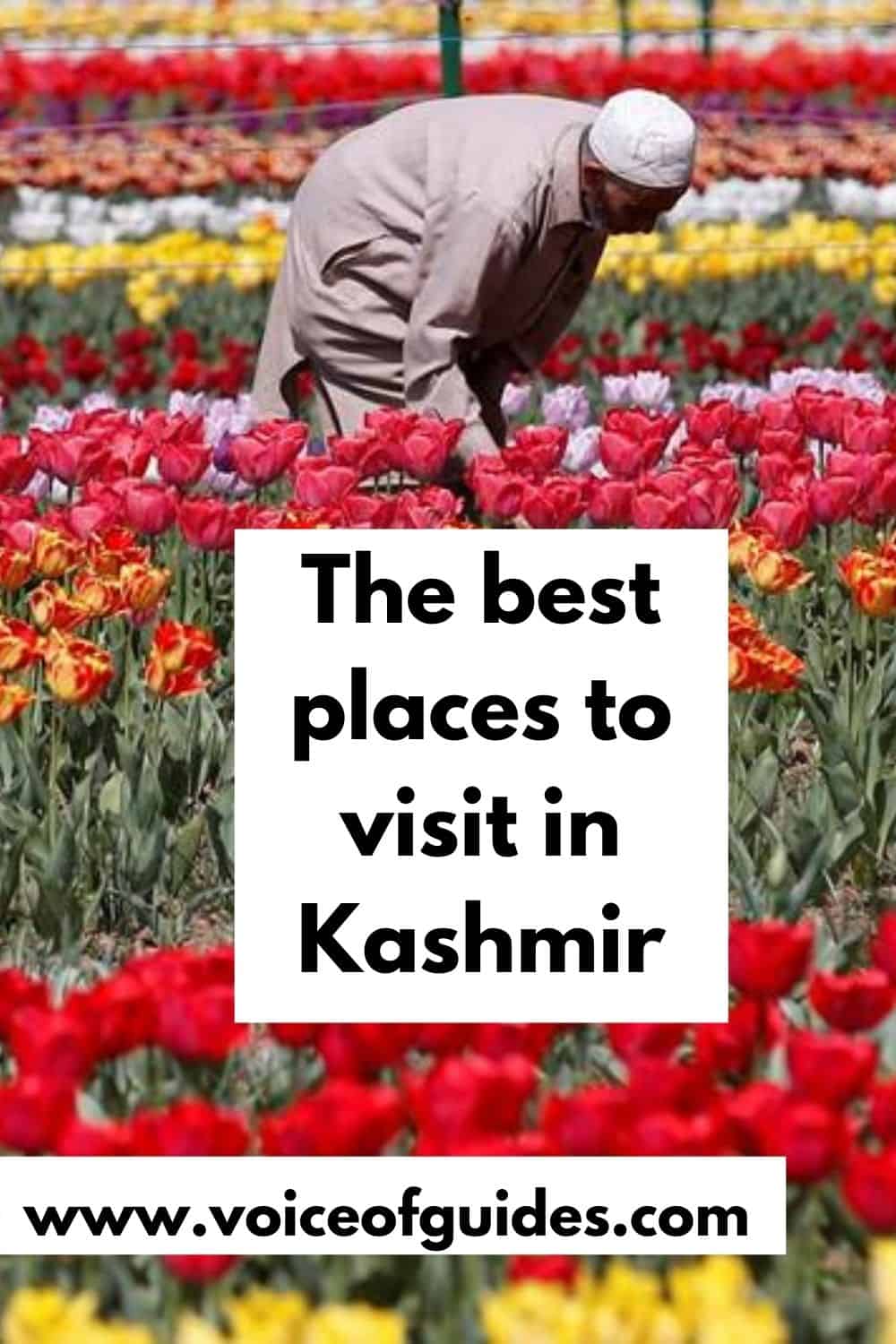
Is it safe to travel to Kashmir in 2021?
The Kashmir valley with Srinagar is on the bucket list of many travelers and is considered safe by now. But the security of the valley can be unstable. When India and Pakistan gained independence in 1947, Kashmir was split between the two countries, but both claim the whole territory for themselves. They waged three wars and two military conflicts for the region that still qualifies as a disputed area.
Pakistan controls 37% of the Kashmir region (85,000 km²), made up of Gilgit-Baltistan and Azad Kashmir. India possesses 43% (110,000 km²), including Kashmir valley, Ladakh, and Jammu, and China also has a share of 20 % (37 000 km²), the Aksai Chin region. It is essential to mention that the part of J&K that became part of Pakistan is scarcely populated and economically underdeveloped with bad road connections.
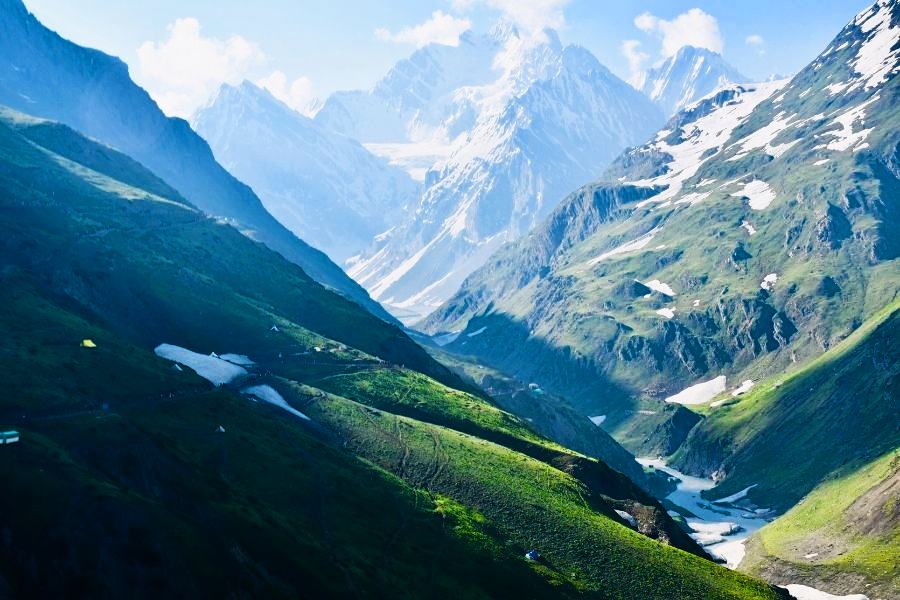
It is all sorrowful because, until 1989, Kashmir was one of the top destinations in India and tourism was a crucial pillar of its economy. The picturesque green valley was the most popular venue for Bollywood film shootings. But after the Islamic terror acts, the cinemas were closed, and it became unsafe for tourists. During the last ten years, tourism in Kashmir saw significant growth, although Indian tourists still outnumber foreigners. Kashmir is a popular honeymoon destination for young Indian couples.
While the vast majority of Kashmiris are peaceful, a small number of extremist separatists often encouraged by the Pakistani government are also present. 600,000 Indian soldiers are stationed in J&K state, making it the highest existing military presence.
Now Kashmir is an exotic and generally safe destination for travelers with several places to visit. But it is always important to get up-to-date information about the current situation. Border clashes are common, and they only occasionally spread to other parts of the valley of India. Then, buses, trains, and flights get suspended, and schools shut down.
How to go to Kashmir?
Flight: Srinagar has a flight connection with some major Indian cities: Jammu, Leh, Mumbai, Chandigarh, and Delhi.
Flight/train + road: Your other option is to take a flight or a train to Jammu and then an approximately 8-9 hours long bus ride to Srinagar. The railway extension till Srinagar is under construction and is expected to be ready in 2022.
It costs 4000 – 6000 INR for a private taxi and 400-500 Rupees for a shared jeep or cab from Jammu to Srinagar.
Road: If you arrive from Ladakh, it takes two days from Leh to drive to Srinagar with a one-night stop in Kargil.
The best itinerary to visit Kashmir and Ladakh
How to get around in Kashmir?
Bus: There are regular buses between the bigger cities. However, the most convenient way is to hire a taxi so that you can have small stops in between. It is much faster too.
Taxi: Ola cabs (www.olacabs.com) is India’s version of Uber. You can use Ola for local rides and even for inter-city or other long trips. Install the app on your phone, place your order, and you’ll be given the driver’s license plate number in advance.
Private Car: Renting a car with a driver gives you the most flexibility. It costs approximately 2.500 INR, including driver and fuel.
Shared taxi: You can also take a shared taxi between the cities. It only departs once it is filled but is much cheaper.
Organized tours: Organized one or more day-tours are another great option to visit the best places to visit in Kashmir.
What is the best time to visit Kasmir?
Unlike Ladakh, which gets extremely cold in winter with only a window of a couple of months for an enjoyable visit, Kashmir is an all-year destination. Protected by the Pir Panjal mountain range from the south, there is no monsoon season in this region. Though, it can rain any time of the year.
The best months for a cultural visit and trekking in Kashmir are between April and October. Even in summer, the weather is pleasant.
The skiing conditions are the best from November to March.
Visit Kashmir in spring (March-early May)
Spring is ideal for trekking in the mountains. The temperature is around 20 degrees, the snow has already melted, and the roads are easily accessible. It is also an excellent choice for those who want to play golf as there are several courses in Kashmir. The one in Gulmarg is the world’s highest golf course at 2650 m.
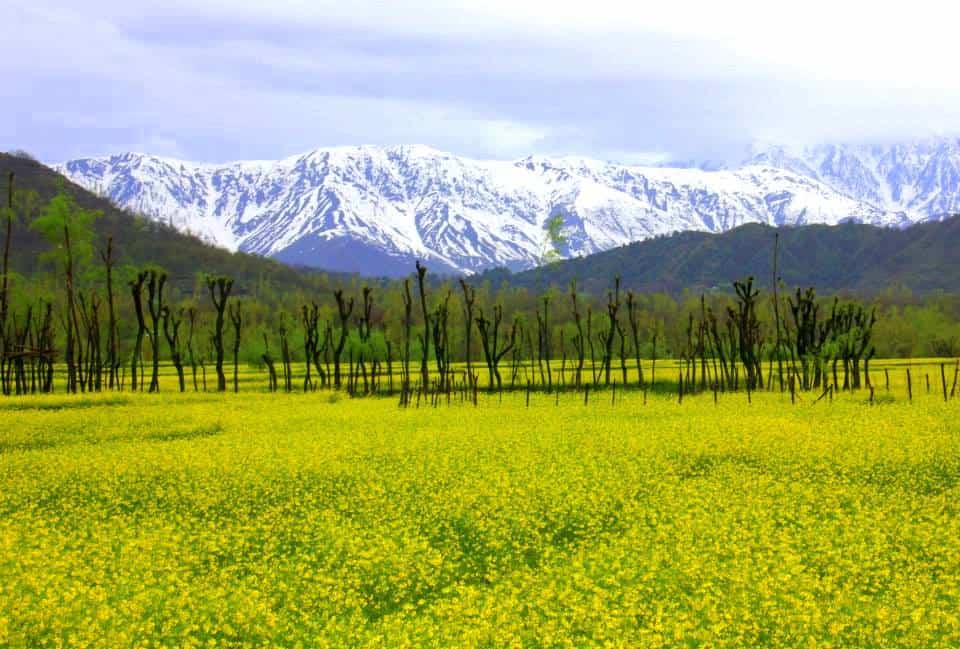
It is also the time to visit the world-famous Indira Gandhi Memorial Tulip Garden in Srinagar, the largest of such in Asia with 1.5 million tulips. The landscape of the perfectly aligned colorful tulips and daffodils is stunning. It welcomes the most visitors during the Tulip festival, somewhere between March and May. The exact date depends on the blossoming.
Kashmir during Summer (early May-late August)
The summer season is the busiest in Kashmir because this is the best time to combine it with a visit to Ladakh. In the high season, hotel prices also increase. Many Indians are happy to escape the scorching heat of the southern regions, and plenty of couples arrive on honeymoon. The temperature can reach 30 degrees, but the mornings and evenings are still fresh.
In July and August, tons of Hindu pilgrims camp around Kashmir and undertake the pilgrimage to Amarnath every year.
The summer is a perfect time to enjoy the famous houseboats and a shikara ride on Dal lake. The flowers of the Mughal garden are in full blossom, and the whole Betaab valley is in picturesque greenery.
Around the Zojila Pass, you will spot some snow even in summer, and Indian tourists enjoy playing snowball for the first time in their life or getting on the back of a yak.
Kashmir during Autumn (September-November)
Autumn is another attractive season in Kashmir when the trees of the expansive forests turn red and yellow. The temperature drops, but it is still not too cold. During the off-season, you can benefit from lower prices for accommodation, transport, and tours.
Plus, the string yellow saffron fields blossom in late autumn in Pampore, not far from Srinagar.
Kashmir during Winter (November-February)
Kashmir is a perfect destination in winter too. The white landscape gives a different beauty to the forests and contrasts most parts of India. Many locals come to enjoy the snow that is not a common experience for most Indians.
Wintersport lovers also flock to Kashmir with plenty of choices for skiing and snowboarding.
Houseboats keep open during winter too. The Dal lake gets only partly frozen, if at all.
Suggested itinerary for five days in Kashmir
Day 1: Srinagar
Day 2: Srinagar- Sonmarg- Zojila Pass – Srinagar
Day 3: Srinagar – Pahalgam
Day 4: Pahalgam – Gulmarg
Day 5: Gulmarg- Srinagar
What are the famous places to visit in Kashmir?
Srinagar – the city of lakes
Srinagar is the summer capital of Jammu and Kashmir State (J&K) and the biggest city of the Kashmir valley with a population of 1.2 million. Since 1872, the capital shifts from Srinagar to Jammu from November till April, in the “Durbar move” every year. Gulab Singh maharaja started the tradition, and surprisingly, the practice persists.
The ultimate guide to Srinagar
Srinagar has a stunning location with a view of snow-capped mountains almost all year round. But first and foremost, Srinagar is the city of lakes. The houseboats, gardens, and shops built on the Dal and Nagin lakes are essential scenes of Kashmiri life.
Houseboats and Shikaras are the symbols of Kashmir
Climb up to the principal Shankaracharya Hindu temple of Srinagar and enjoy the stunning view of Srinagar.
The Mughal Emperors, especially Jehangir, adored Kashmir and used it as a summer retreat. The colorful gardens, Shalimar Bagh and Nishat Bagh, are reminders of this period.
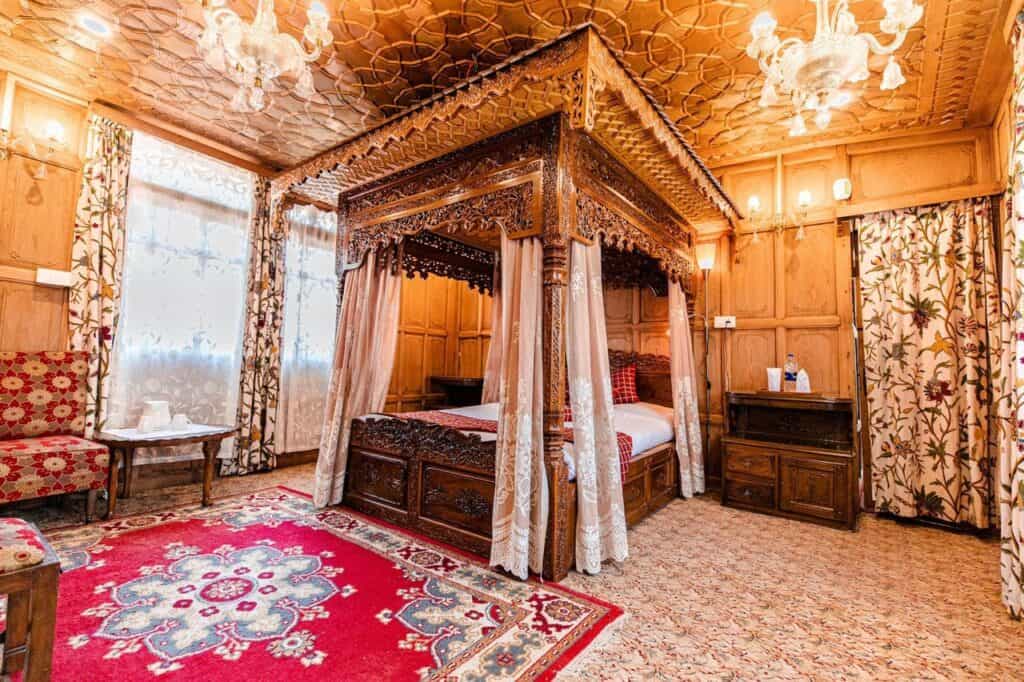
Visit the famous mosques (Jama Masjid, Hazratbal Mosque, Shah Hamadan, Rozabal Mosque, and Shrine), stroll around in the old city packed with Kashmiri-style wooden houses and take a shikara ride on the Dal Lake.
1. The archeologic sites of Martand and Avantipur
You can cover the Martand and the Avantipur temples in a half-day trip from Srinagar or on the way to Pahalgam.
The temple ruins of Martand are the oldest of the sun temples built outside ancient Greece and Rome, dating back to the 8th century. It stands on the hillside near the town of Mattan. There is another Sun temple in the same village, so do not let the locals confuse you. The site at Martand consists of a large courtyard surrounded by a ruined peristyle colonnade and an impressive temple with numerous smaller shrines nearby. The fluted Doric columns, pediments, and cornices that are reminiscent of Greek architecture are particularly striking.
The Avantipur temples were part of the capital in the 9th century during the Hindu monarch, Avantivarman. The two temples are 1 km apart, but you can spot both of them from the Srinagar-Jammu highway. It is nice to stroll around among the ruins of this ancient masterpiece and observe the intricate carvings.
The southern, smaller temple, called Avantiswami, is dedicated to the Hindu God Vishnu. It is in better condition than the northern and was the private shrine of the ruling family. The Avantiswara Temple is dedicated to Shiva and was probably Avantipur’s public temple.
Entrance fee: Locals Rs 10 / For foreigners RS 100
Opening hours: 9 am to 6 pm
2. Achabal and Verinag springs
Kashmir abounds in springs, surrounded by stunning gardens. The two most famous are Verinag and Achabal.
Verinag is considered the source of the Jhelum River and is also called the Gateway to Kashmir. The Verinag spring is an octagonal pool with striking blue water. Outside the pool, a canal leads to the actual source of the Jhelum River, the backbone of the Kashmir valley. The Mughal Emperor, Jehangir, built it together with the surrounding arcades and the adjacent garden. His son, Shah Jahan, extended it with cascades and aqueducts. They were both amazed by the beauty of Kashmir and built plenty of recreational gardens with pools and fountains in Kashmir. Jahangir loved it so much that he asked to be buried at Verinag gardens, but his wish was denied.
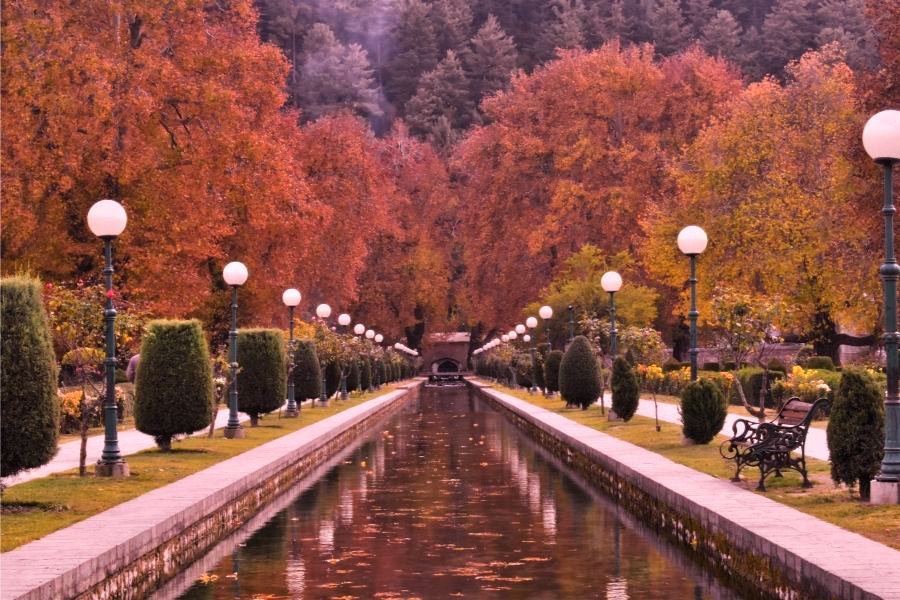
The royal couple designed the palace and garden at Verinag, which became their favorite place in Kashmir. Pine-covered hills rise sharply behind the spring, which surges up into a deep pool of emerald water, and it is not hard to see why Verinag was always considered a sacred place.
The Achabal garden was created by the powerful wife of Jehangir, Empress Nur Jahan, as a summer retreat. Apart from cascades and fountains, they even built a mosque in the garden.
How to get there: Verinag is 26 km, Achabal is 8 km away from Anantnag, the commercial and administrative capital of the district of the same name.
Entrance fee: free of cost
Opening hours: 7 am to 7 pm
3. Pampore – the center of the renowned Kashmiri saffron industry
The Kashmiri saffron has one of the best qualities in the world, and the history of its cultivation goes back to the 10th century. The saffron center of Kashmir is in Pampore, 15 km from Srinagar. Here, they produce more than 200 kg of saffron every year. The treasure of the flower is the capillary purple part in the middle. You have to come late autumn to see the expansive yellow saffron fields in their full beauty.
4. Pahalgam (90 km/2 hours from Srinagar)
Pahalgam, called the village of shepherds, is one of the famous hill stations at 2200 meters next to the Lidder River. The vivid green meadows attract several tourists. It is the base camp for the Hindu pilgrims during yatra (July and August) every year, when the countless tents envelop the city and its surroundings. The pine forests and the surrounding snow-capped mountains make it an attractive place with dozens of charming summer vacation cottages in a village of only 5.900 inhabitants.
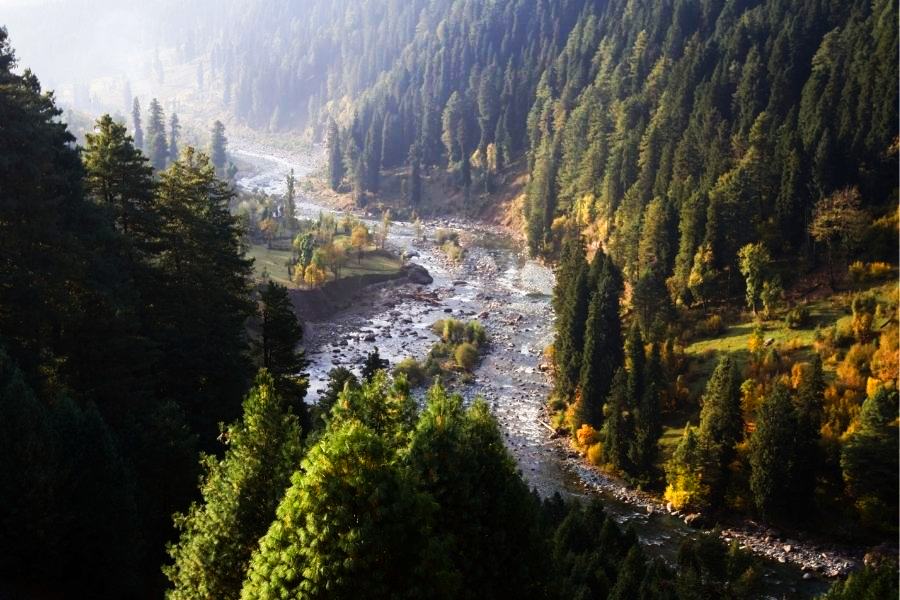
Pahalgam is also one of the main starting points for hiking and a paradise for river rafting. Due to its jaw-dropping landscape, Pahalgam was the scene of many Bollywood shootings.
What is Amarnath Yatra?
The Amarnath cave, one of the holiest places in Hinduism, is located at 3888 meters. The cave is enveloped in snow most of the year, except for a few months in the summer when pilgrims make the long march from Pahalgam. Hundreds of thousands of Hindus make pilgrimages every year. Inside the cave, there are 40-meter-high stalactites. One of the stalagmites is considered a Siva lingam. According to Hindu belief, the size of the lingam increases and decreases depending on the orbit of the moon. It is a sacred place because God Siva explained the secret of life and eternity to Parvati in this cave. The main pilgrimage is when the ice lingam reaches its maximum size during the summer between July and August. The pilgrimage to the lingam is called Amarnath yatra. It is a 43-km-hike from the Pahalgam base camp, with the possibility of staying in camps overnight on the way to the cave. The pilgrimage represents a vital revenue for the government and a principal source of income for the local Shia Muslim Gurjar-Bakarwals tribes who sell food, drinks and assist the pilgrims.
Recommended hotels in Pahalgam
Hotel Pine n Peaks – 5*
Hotel Pahalgam – 4*
Hotel Heevan – 4*
Hotel Grand Mumtaz – 4*
Hotel Paradise Inn 3*
Hotel Mount View 3*
Hotel WoodStock 3*
Hotel Pine Spring 3*
Check out the price and availability of hotels in Pahalgam
5. Betaab valley (Hajan valley), Chandanwari and Baisaren
Once you are in Pahalgam, take a small tour to the Betaab valley on the way to the charming Chandanwari village. It is one of the several sub-valleys of the Kashmir valley that was the shooting place of the “Betaab” Bollywood movie, hence its name. Some people make a day-trek from Pahalgam to the valley along the crystal-clear Lidder river and waterfalls. You can take a car directly to the picturesque Chandanwari village 16 km from Pahalgam. The curvy road passes by incredible sceneries. It is the starting point of the Amarnath Yatra pilgrimage as well.
Chandanwari is a perfect place for trekking, pony rides, and snow sledding on a snow bridge.
Hajan on the way is an idyllic spot for a picnic.
Baisaren, a small village amidst pine and fir forest, called Mini Switzerland, is only 4 km from Pahalgam. You can either take a pony ride or hike there. It is a quiet, offbeat tourist place that resembles the Alps with its perfect green meadow and surrounding mountains. It became known from the Bollywood movie “Bajrangi Bhaijan” starring Salman Khan. From Baisaren, you can enjoy the stunning view of the Lidder valley and Pahalgam.
The station awaits you with some activities: horse riding, ziplining, zorbing, and hiking.
6. Gulmarg (52 km/1.5 hours from Srinagar)
A spectacular road along maize and rice fields leads to Gulmarg, the meadow of flowers. It got its name after the colorful Bluebells, Daisies, Forget Me Not’s, and Buttercups covering the valley in springtime. The 3-km long and up to a kilometer wide Gulmarg valley has one of the highest golf courses in the world at 2650 m, which attracts several visitors during spring and summer. Being the most famous ski resort in Kashmir, it is an exciting place in winter too. If you come for skiing, be prepared for off-piste, deep-powder, long-run skiing, and snowboarding.
It is possible to visit Gulmarg on a day trip from Srinagar, but I suggest staying for at least a night to make the most out of it. The best thing to do is hiking and enjoy nature. On clear days you see Srinagar and Nanga Parbat, the ninth highest mountain (8 126 m) from Gulmarg.
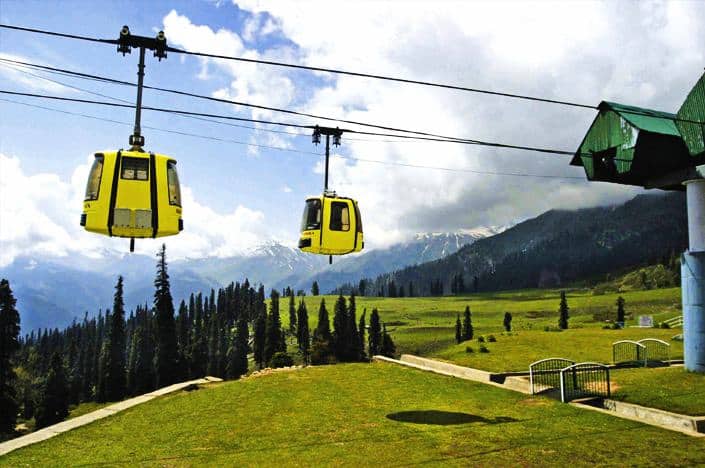
The best thing to do is to take one of the highest cable cars in the world. It starts from the Gulmarg resort (2600 m) and takes the guests first to Kongdoori station. The second stage goes up to the Kongddori mountain (3747 m) near the Afarwat peak (4200 m).
The gondola works every day from 10 am to 5 pm. It costs 700 INR for the first and 900 INR for the second stage. It is also possible to take chair cars instead of the gondola.
Recommended hotels in Gulmarg
Hotel Khyber Resort & Spa – 5*
Hotel Vintage – 4*
Hotel Heevan – 4*
Hotel Grand Mumtaz – 4*
Hotel Royal Park 3*
Hotel Pine Springs 3*
Check out the price and availability of hotels in Gulmarg
7. Sonmarg (80 km/1.5 hours from Srinagar)
Sonmarg, the “Meadows of Gold,” is another mountain village with only 1,000 inhabitants 80 km from Srinagar. In summer a popular place for trout fishing. It is also the starting point of several treks in spring and summer and turns into a crowded ski resort in winter.
The road to Sonamarg continues to Ladakh through the Zoji La Pass. There are several things to do in Sonmarg, which is one of the most famous places to visit in Kashmir. Trekking is the best way to discover the beauty of the village. Kashmir is famous for its stunning lakes, and some of the most attractive ones are around here. You can trek to the Gangabal, Vishansar, Gadsar, Satsar and Kishansar lakes. The Satsar lake is one of the most beautiful, located at 5000 meters.
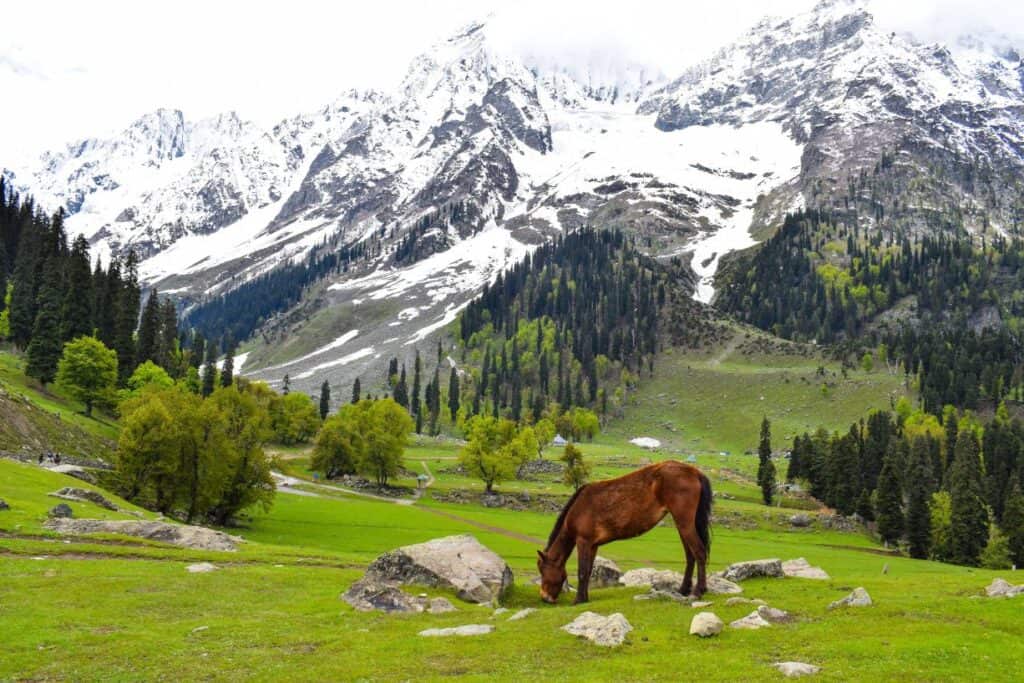
You can also get closer to the Himalayan glaciers, like the Thajiwas, Kolhoi, and Machoi Glaciers.
The famous Kolhoi Peak, Amarnath Peak, Machoi Peak, and Sirbal Peak tower over this charming hill town,
Sonmarg is also an ideal place for white river rafting.
The Baltal Valley near the Zojila Pass is a must-stop for the jaw-dropping scenery. It is also a base for the Amarnath Yatra.
Recommended hotels in Sonmarg
Hotel Rah Villas – 4*
Hotel Sultan Resorts – 4*
Hotel Village Walk – 4*
Hotel Snow Land – 3*
Hotel Glacier Heights – 3*
Hotel Villa Himalaya 3*
Check out the prices and availability of hotels in Sonamarg
8. Zojila Pass (3528 m)
The Zojila Pass is the only road connection between Kashmir and Ladakh, although the Indian government approved a tunnel that would be a game-changer in transportation. It would reduce the driving time from 3 hours to only 15 minutes. If you come to Kashmir from Ladakh, you have to cross the Zojila Pass non-accessible during winter.
The concept of hairpin bends gets another meaning when you cross the Zojila Pass. The 25-km-long drive is one of the most dangerous areas in the world that requires professional skills and constant concentration. Even though the road is called National Highway 1, it is unpaved on top of the Pass. Huge trucks and small cars maneuver on the narrow path without any protective barrier. The view is stunning, but it is hard to enjoy while coming across several heart-stopping moments. However, it is an adventure you can not miss once you are in Kashmir.
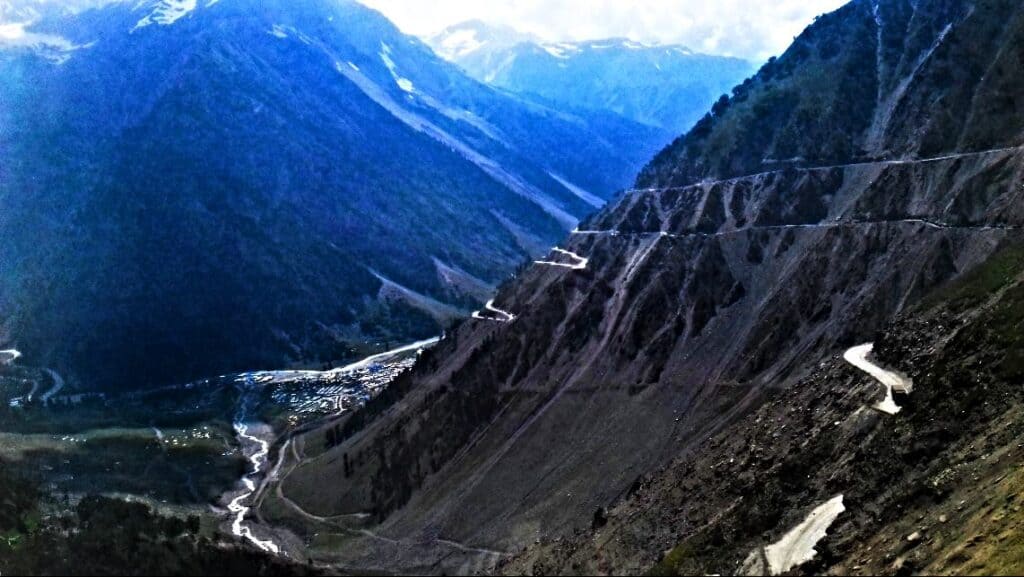
There are photo points and places to have a snack or snow sledge once you are on the top.
The Zojila Pass is 15 km from Sonmarg and 100 km from Srinagar.
9. Kheer Bhawani temple (25 km from Srinagar, 1 hour)
The principal temple of the small Hindu population (called Kashmiri pandits) of the Kashmir valley is located along the main road to Sonamarg. Bhawani is the reincarnation of Goddess Parvati. First, the temple was called Bhawani Mandir. But since it became common for devotees to make “kheer” (rice pudding) offerings to the Goddess, it has become known as the Kheer Bhawani temple.
The modern temple, dedicated to Ragnya Devi Goddess, was built by Maharana Pratap Singh in 1912. The holy spring around the shrine even changes its color miraculously. Some people reported having it seen in red, pink, orange, blue, and white. When it turns black, it predicts tragedy for Kashmir. According to Hindu mythology, Ravana, the demon of Sri Lanka, offered kheer to the Goddess, and since then, she was called Kheer Bhawani.
When Rama freed his wife, Sita, he asked his trustworthy companion, the monkey Hanuman, to relocate the sacred image of Ragnya Devi. That’s how it ended up in Shadipora, in J&K, placed in a small shrine.
What is unique for this temple is that the devotees offer “kheer” to the sacred spring that is the Goddess itself. The devotees poured so much kheer in the basin that they had to clear it. At that time, they discovered the ruins of an old temple and other engraved slabs.
Maharana Pratap Singh was a devotee of the Goddess and decided to build a small shrine out of white marble in the middle of the spring.
Opening hours: 6 am – 8 pm
Entrance fee: free of cost
10. Chrari Sharief (30 km from Srinagar)
Chrari Sharief is a town and the holiest Muslim pilgrim site in Kashmir. It gives home to the Chrari Sharief mosque, where the Sufi SaintNund-Reshi, also called Sheikh Noor-ud-din Noorani, offered his prayers in the 15th century. His remains are also kept here. The saint renounced from worldly life at the age of only 12. From then on, he devoted his life to searching for the grace of God. In 1995, the holy site became a battlefield between an Islamist militant group and the Indian armed forces. Several militants died, houses and shops were destroyed or damaged, and the people escaped to other villages to find shelter. The shrine also got demolished in the gunfight. Since then, the authorities rebuilt it in its original form, and both Muslims and Hindus consider it a sacred place.
The famous saying of the saint, “Food will sustain only when jungle’s sustain,” became the slogan for environment protection campaigns in Kashmir.
The best time to visit Chrari Sharief is during Urs, his death anniversary in October when devotees of all faiths come to partake in the saint’s blessing.
It is on the way to Yusmarg, and there are several buses from Srinagar.
11. Yusmarg (50 km/2-3 hours from Srinagar)
Yusmarg is a quiet, secluded valley surrounded by the highest peaks of the Pir Panjal range, like Sunset Peak (4746 m) and Romesh Tong (4700 m). The Ahmadiyya Muslim Community believes that Jesus passed through this valley on the way to Kashmir, hence its name, “the meadow of Jesus.” Pine and fir trees dominate the valley that is ideal for nature lovers. The Doodh Ganga river is only a 2-minute-walk from the meadow, but another option is to approach it with horses.
Agents in Srinagar offer adventurous trekkings and peak-climbings.
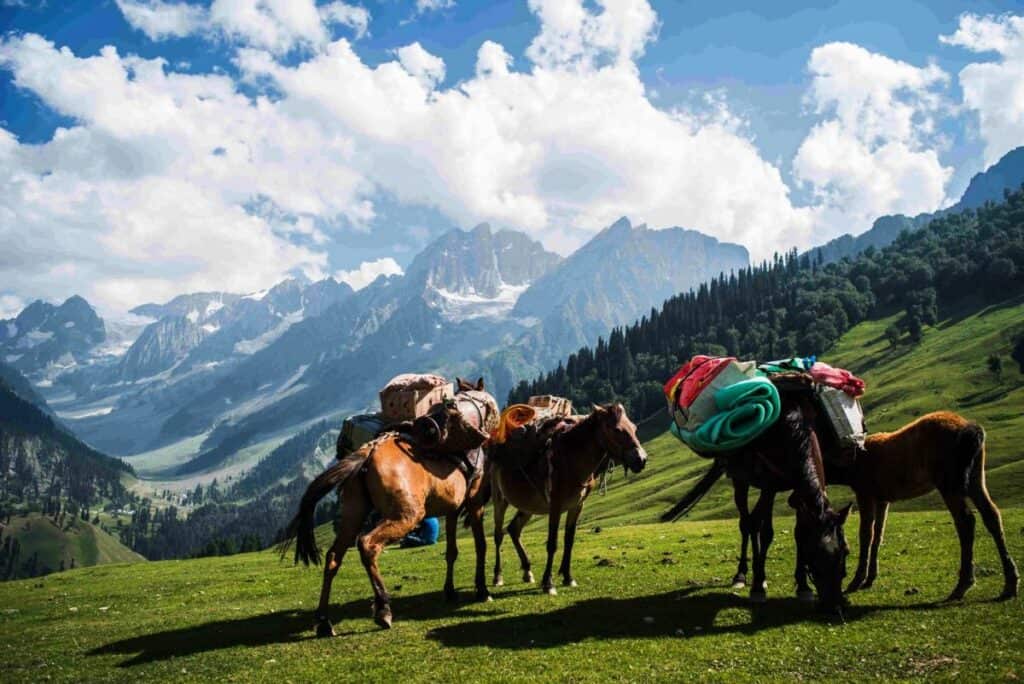
Since Yusmarg is a tiny village, it has no bus connection with Srinagar. But you can easily catch a bus to Chrari Sharief and then take a shared or private taxi to Yusmarg.
The Kashmiri cuisine – the famous wazwan
Kashmiri cuisine is one of the best in India. It is a blend of Central Asian, Afghan, and Persian traditions. The Kashmiri cuisine is well-known for the overwhelming meat dishes usually served with rice.
Cooking is a real art for Kashmiri people. They eat fish, chicken, and lamb, but never beef or pork. They also do not favor lentil (dal), which is famous in other parts of India.
The essential spices in Kashmiri cuisine
The wide range of spices is the heart of the Kashmiri kitchen. Garlic, cinnamon, cardamom, ginger, fennel are the most frequent. And of course, as Kashmir is a leading exporter of saffron, it gives a unique flavor to Kashmiri sweets and rice. They often add dried fruit to the meals.
The Kashmiri wazwan
It is a multi-course menu, the most traditional part of Kashmiri cuisine. The wazwan is not one, but 36 different dishes and at least half of them are meat or fish. Wazwan comes from the Kashmiri words “waz” (cook) and “wan” (shop). The wazwan is usually cooked by wazas (cooks) under the supervision of “vasta wazas” (chief cooks). The preparations start already the day before when they pre-cook the ingredients.
Wazwan is not an everyday meal but is a must during special Kashmiri occasions, like weddings. Since they pass the recipe from generation to generation, outsiders have few chances to learn how to make the Kashmiri wazvan.
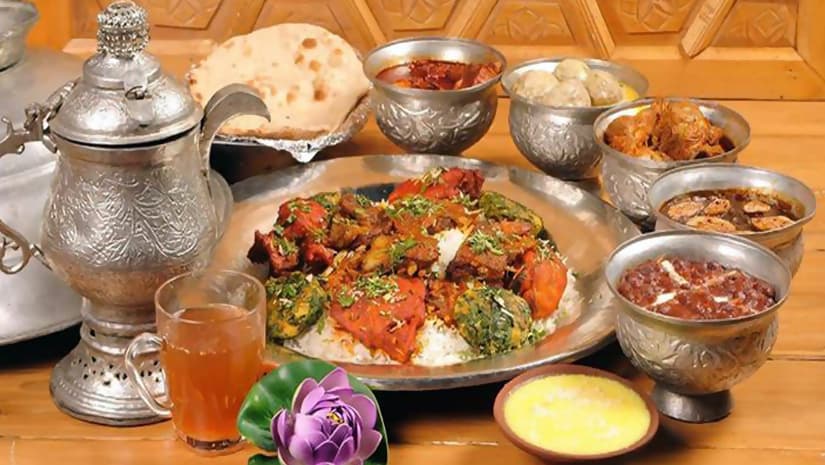
They serve the wazwan on a large brass plate designed for four people.
It is also a traditional meal of the Kashmiri pandits (the Hindus in Kashmir). Only their prayer before starting the meal differs from the Islamic way. Muslims pray to Allah, while Hindus pray for God Rudra.
The wazwan always comes with several sauces and garnishes, like chutney or yogurt sauce.
The dishes of the wazwan are flexible, but the feast must contain the following seven:
– Tabakhmaaz or Qabargaah: grilled ribs with milk, butter, and spices
– Rista: spicy, greasy meatballs with saffron and pepper
– Damiwal Korma: spicy roast lamb, with onion puree, yogurt, and coriander leaves
– Rogan Josh: one of the symbols of Kashmiri cuisine, lamb stew with Cashmere chili, yogurt, and ginger
– Gushtaba: spicy yogurt with meatballs
– Marchhwangan Korma: chicken thigh or leg with spicy onion sauce
– Aab Gosh: large lamb with condensed milk, cardamom, fennel-based spice mix
Rogan Josh, Aab Gosht, Goshtaba, and Tabakhmaaz are the most famous Kashmiri dishes.
Yakhni is another unique dish of Kashmiri cuisine. It is saffron and yogurt-based mutton curry best served with steamed rice.
Dum Aloo: boiled potatoes filled with lots of spices
Taman: goat cheese
Kashmiri bread
Kandur is a traditional Kashmiri bread with sesame or poppy seeds on the top.
Kulcha: small, round, dry, hard, with hazelnuts on top.
Lavasa: large thin flatbread, usually served hot and popular for breakfast
Kashmiri tea
Out of the several types of Kashmiri teas, the Kashmiri Kahwa is the most unique. The Kashmiri Kahwa is a green tea with a range of spices: cardamom, cinnamon, saffron, and occasionally Kashmiri roses. Crushed almonds and walnuts, sugar, or honey are also added to that. Apart from the Kashmir valley, it is also widespread in Afghanistan and Pakistan. It is strange that sometimes they omit green tea and entirely replace it with herbal ingredients.
The Kahwa has numerous beneficial effects on health. Besides being a remedy for a cough and cold, it is rich in antioxidants and strengthens the immune system. It helps you lose weight as it boosts your metabolism.
There is a particular way to make the Kahwa in a copper kettle, called samovar. Although, they do not always stick to this formality. Kahwa always comes after the hearty wazwan as part of the meal. But Kashmir has no tea plantations. It imports from the neighboring Kangra region in Himachal Pradesh.
Here you can find the recipe of the authentic Kashmiri Kahwa.
The other typical tea specialty of Kashmir is the Noon Chai black tea, also called pink tea because of its pinkish color. It contains gunpowder tea (green tea leaves rolled into small balls), milk, sea salt, and baking soda.
The famous Pashmina shawl and Kashmir handicrafts
Kashmir is a perfect place for shopping with several typical products: hand-knotted Persian-style carpets and rugs, papier-mâché, woodcarvings, Pashmina shawl, and metal works.
Kashmir’s art started to flourish when Islam spread in the valley, and it established commercial ties with the Muslim world, especially Iran. Shawl-weavers and the papier mâché painters probably arrived from Iran and established a Shia Muslim community. Many of the older generations still speak Persian, and until recently, it was common for them to return to Iran for the last part of their lives. The craftsmen of Kashmir often worked under inhuman conditions for starvation wages.
The best itinerary to visit Kashmir and Ladakh
The Kashmiri Pashmina shawl
Pashmina shawl is probably the most well-known product of Kashmir. It became a dream for women to have one and prestige for affluent ladies to have a whole collection of Kashmiri shawls. Empress Josephine, the wife of Napoleon, is said to have had 200 of them. The shawl is made from the soft under fleece of the Cashmere mountain goat found far away in Tibet and Central Asia. It does not bear the name of the valley. They use different natural plants and fruit to color the shawl: indigo for blue and green, logwood for red, saffron for orange and yellow.
But the devastating famine of 1877 wiped almost all shawl-makers out, and the art vanished with them. Those who survived switched to the carpet business. Fashion changed, and there was no more demand either. In the second half of the nineteenth century, low-grade copies of the Kashmiri shawl flooded the international markets, and now the Pashmina shawl brand is completely misused. You can find them for only 10 USD in Europe, which has nothing to do with the authentic Pashmina shawl.
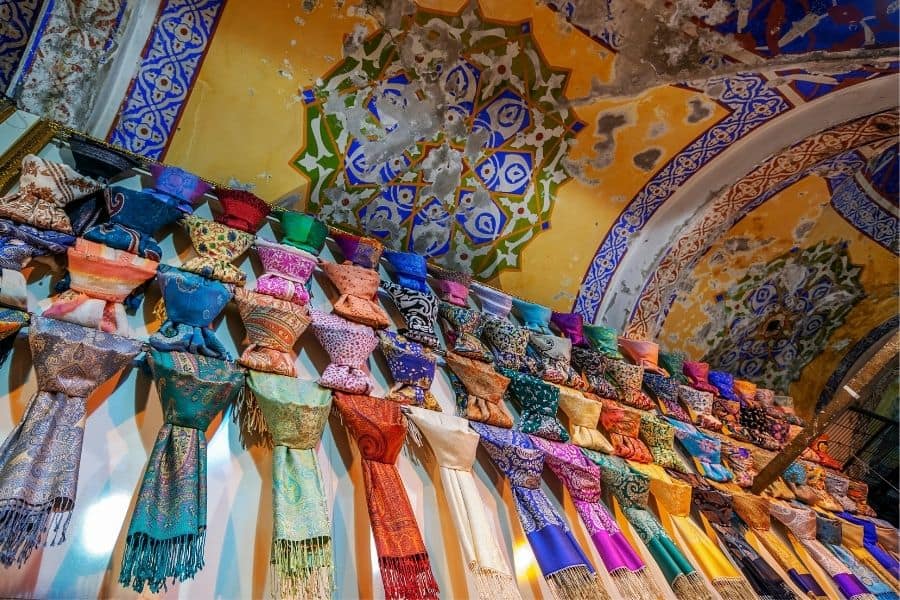
It is hard to find genuine Pashmina shawls nowadays that are the second-best quality after the shahtush shawls today. Shahtush shawls (meaning king of fine wools) are exceptionally soft and light but still warm. A top-quality shahtush can cost thousands of dollars, and only a master weaver can make it. It is currently the highest quality wool on earth, which comes from the down fur of a Tibetan antelope called Chiru. It is banned now because the animal is on the verge of extinction. But Kashmir still produces it secretly to satisfy the Western demands.
There are mixtures and blends of shahtush, pashmina, and ordinary wool, and finally, there are shawls made entirely of regular wool.
The other craftsmen—the metalworkers, the woodcarvers, and the papier mâché painters—had survived the bad years, and their work did not depend so much on fashion. There are over 1000 families who live from making papier mâché, but the real masters are rare. This Kashmiri specialty dates back more than 1,000 years. It is prepared by soaking the paper, drying it in a mold, painting it with intricate patterns, then lacquering it.
Tip: If you decide on buying any product, you have to be attentive as there are many low-quality products around. At the same time, you can find real gems in the shops in Kashmir.
Kashmir is a unique corner of India that is mainly a paradise for adventure seekers. There are several hiking trails from Sonmarg, Gulmarg, and Pahalgam hill stations to lakes, glaciers, and high passes. Srinagar has a rich cultural heritage with stunning Mughal gardens, temples, and mosques, where you can enjoy the unique hospitality of a traditional houseboat, take a Shikara ride to discover the Kashmiri life on the water. If you have more time, it is ideal to combine your visit to Kashmir with Ladakh on the other side of the Zojila Pass dotted with Tibetan monasteries. Kashmir is safe, but you always must check the current situation.
Useful resources for your travel to India
Insurance: Safetywing insurance that covers COVID-related issues as well.
Train, bus and flight ticket: Book your train ticket at Indian Railways website, or 12Go which gives you the best option (train, bus, and flight) based on the city of departure or arrival.
For your flight ticket use Google Flights.
Accommodation: Booking.com and Hostelworld.com offer a wide choice of low and higher-budget hotels.
Local tours and tour packages: Viator and GetYourGuide offer transfers and several one or multi-day tours.

